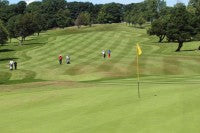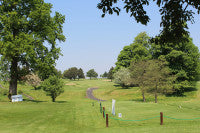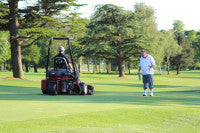Every day is Captain’s Day

The course, measuring 6512 yards with a par of 71, was designed by James Braid in 1932 and provides a challenge to every golfer, especially the demanding seventeenth, known as 'Braids Best', and the daunting elevated tee to the final green. Braid's achievement was to construct a course in harmony with the existing landscape that did not prevent him from introducing spectacular touches of theatre; the most striking of which comes after the 11th when, suddenly, the course reveals an unexpected seaward aspect looking out towards Morcambe Bay.
Course Manager Warren Bevan and his deputy, Carl Hamlett, are something of a rarity in that they are both named as officials on the club's website, a clear indication that their work is valued.

Four additional greenkeepers help to maintain the eighteen hole course and practice ground. The site covers a total of 150 acres - 9,000m2 of green, 10,000m2 of tees and approaches and fifteeen hectares of fairway. In addition, there are 3,000m2 of bunkers. The rest is managed
rough, wild rough and mature woodland.
"I train all the staff to be competent on all operations so that all jobs can be covered during holidays and absence. However, running up to a big event, we give specific jobs to the staff so they can take extra pride in their area of the course."
The club also employs a maintenance man and part of his job description is to cut the lawns around the Hall. The only other help comes from one of the club's members, Allan Smith. "He is an excellent digger driver and shaper," says Warren. "I use him for all our construction work and we have had a very successful relationship over the last ten years. We are also considering employing an apprentice in 2015."

"I completed my HND in Sports Turf at Myerscough College, which involved a work placement at Greetham Valley Golf Club, where I also completed my NVQ Level 2. The foundation degree allowed me to grow my knowledge of turf grass management and gave me the desire to continue my need to acquire more information about maintaining golf courses to a high standard. I have attended many more courses since, and this has allowed me to discuss any subject with my peers."
"It was whilst studying at Myerscough that I met the two people who have been an influence on my career. Firstly, Martyn Jones, my tutor at Myerscough. His enthusiasm for golf courses was infectious and he was always there to support me long after graduating. The second was Adrian Porter, Course Manager at Greetham Valley. He was a great mentor to me when I was an apprentice and gave me a great introduction and foundation into golf course management. Twenty years later, I now have the pleasure of passing on my own experience to the next generation of turf managers."

"Presentation ranks very highly with me," he continues. "First impressions are so important, and I say to the team 'every day is Captain's Day'. My personal drive comes from my mindset that, if my golfing hero, Nick Faldo, was to tee off, would I be satisfied he would have a great golfing experience and, if I believe all the boxes are ticked, I have surpassed any other expectations." Warren enthused; "I have been privileged to have walked on some of the world's greatest golf courses. On many trips to the USA, I have spoken to many a high profile superintendent to glean as much information about presenting a course in tournament ready condition. This, I believe, has made Lancaster Golf Club the talking point it is today."

Warren explains that the entire site is boulder clay. "The greens were originally a push up clay construction. Twenty years ago, the club rebuilt nine greens with a sand profile and, in the last few years, I have rebuilt two more. With the greens having had many years of topdressing, the top of the profiles are very similar. The push up greens do retain more moisture and nutrients, so I do have to adjust feeding programmes and watering requirements to achieve nineteen consistent greens," he confesses. "I do find this a good challenge. The club invested in a new irrigation system in 2005 - nearly ten years later, I finally had a summer where we could use it!"
"Aeration is key," Warren expresses, quite deliberately, "combined with sand dressings. We aerate the greens every three to four weeks through the season with 8mm pencil tines, the verti-drain is also used as part of my soil aeration programme. Keeping air in our soil profile and moving water with penetrant wetters allows for a firmer green with more microbial activity, meaning we aim to get maximum potential out of the products we apply and healthy turf."
"The topdressing programme on greens starts in March and then every two to three weeks into late May. I generally don't dress the greens in June, July and August due to a hectic programme of events. We then finish the year with several dressings, normally around 150 tonnes of straight sand is applied annually. To complement the sand dressings, we verti-cut every three weeks through the season into late summer."

"The nutrition programme generally starts with two or three granular applications, then we move into a fortnightly to three week spoon feed programme with liquid fertiliser and seaweed. My greens do leach nutrition, especially during periods of high rainfall. My target for nitrogen starts around 180 to 200kg, bearing in mind around 25% will be lost to the drains and the atmosphere and not taken up by the plant, but this can increase or decrease depending on what the weather conditions do and the plant tells me. For example, in 2012, I had to apply an extra feed as the wet summer was washing nutrients through."
Warren continues; "I generally maintain the greens around 2mm from early April to late September using our Toro 3250 and 1000, with a rolling programme to tune the surfaces for competitions. I aim for daily stimpmeter readings of 11.2, which has been our USP here at Lancaster."
"I have moved away from a wetting agent programme in the last three years and have seen a drastic improvement in the firmness of the greens, despite years of sand dressing. I have never believed a product with retaining and penetrating qualities can actually do both at once," he states. "I have also seen big improvements in root growth now water is not being held in the profile. I do hold a small stock of retaining wetting agent to apply during extended periods of drought. I opted for this approach, rather than a programme, as I am in the North West of England and it rains a lot. I felt a routine programme was wasting a tight budget and the club's money. I do apply penetrating wetting agent once the weather turns, especially through autumn."

"I have always worked on the principle of presentation and defining a golf course. To achieve this, we mow fairways, semi-rough and tees/approaches three times a week with a fleet of Toro machinery. This keeps the sward tight and as close to my target of championship conditions every week, given staff and budget constraints. Our members prefer the fairways to be mown in a diamond pattern, which does suit the style of the course. I introduced fairway mats in autumn 2013 and these have been a real success. The members got used to them very quickly and saw the benefits in spring."
"The nutrition programme on fairways varies depending on conditions. We gave them a light granular feed in spring this year, then a liquid application of nitrogen with seaweed and iron prior to the club championship. We have had fantastic feedback from members and visitors about the fairways this year. Annually, they get verti-drained and scarified, depending on weather, growth and budget."
"Bunkers are generally raked four times a week, with just foot prints taken out on the other days. Maintaining bunkers takes a lot of man hours, with trimming the edges and distributing migrated sand," Warren explains. "There has been a benefit using PGRs on bunker surrounds. The cup positions are rotated around three sections four times a week."
Warren confirms that the course stands up very well in all seasons to the point where temporary greens are not required. "However," he continues, "if we are remodelling a bunker around a green, for example, then I will mow out an area on the fairway to allow us to get on with the work."

"We have also addressed bunkers due to the changing weather patterns. We have installed 'bunker mat' to reduce wash out or, in some cases, filled in the bunkers completely to reduce costly input."
Warren says that there is always something that needs his attention outside of the general day to day management. For example, a steep bank on the 18th hole was covered in large burdocks which the members didn't like. "In spring, we sprayed off the area, stripped the top few inches and hydro-seeded with fine grasses and a wildflower mix. The area has taken well, but it will be next year before we see the full benefit."
"The woodlands are also managed by us," continues Warren. "I had an arboriculture consultant conduct a full survey of all the trees on the course and, between us, we put together a management plan. We also have several miles of stone walls around the estate which need continual repair."
"If we need specific expertise, advice or skills, like rebuilding a 12th century wall for example, then we call people in, but most work is carried out by my staff with the help of the aforementioned member/digger driver, as required."

"Both companies provide excellent customer aftercare and superb delivery on parts. They are part of our team," enthuses Warren.
"The purchase of a Toro ProCore 648 has made aeration so much easier and more accessible, whilst our new mounted sprayer has made spraying more versatile, again allowing us to spray fairways in-house and access smaller tees and hard to reach areas the tractor mounted sprayer could not reach."
"We have a Waste2Water washdown system to ensure that we comply with all current legislation, and we also keep all our fuel and pesticide storage on the concrete pad."
Asked if there was anything else Warren would like, he replied; "an Air2G2, more staff and a better maintenance facility, although I am aware that we fare better than many clubs."
As for pests and diseases, Warren says that leatherjackets are an issue; "which we treat as needed on greens and tees, but tolerate them elsewhere. I spray for weeds annually, but just target the weed, not a blanket approach. This is due to cost and an environmental approach to needless waste of product," explains Warren. "Moles are a nuisance, I have a registered company come in and manage moles with traps and pellets, other than that, Fusarium is the usual disease we have to contend with as we have Poa annua/Bent greens."
"After golf, I see the course as my nature reserve. We do everything to encourage wildlife; bird and owl boxes, meadow grass land, woodland management, that sort of thing. All the members added £1 to their competition entries for one month to allow us to purchase around fifty bird boxes and some owl boxes."
"Perhaps surprisingly, we do not have any rabbits on the course, but we do have hares, which do no damage, and the members and my team enjoy watching their antics. We also have a family of Roe deer and we have to put tree guards on new trees to stop them stripping the bark."
"Badgers dig up some areas, but mainly after a period of hard frosts when they venture on to the course. I tolerate them though; as a wildlife lover, I enjoy watching them in the early morning. I've also been known to go in at dusk to show interested members who have never seen a Badger."
"We have more wildlife and birdlife than the majority of our local farms," states Warren with a hint of frustration. "Yet programmes, like the BBC's Countryfile and Springwatch, have never visited a golf course. We are still seen as blots on the landscape, which is just not true."
"I believe we should be encouraging the local press and media to do features on our courses to let the public know all about the ecology projects we are undertaking."
Warren is now on a roll. "Our industry has come a long way thanks to the associations, but I feel individuals have to raise their own profile at their own club, be accessible to their members and be seen by the media."

"The downturn of paying members has put a lot of strain on club budgets and capital expenditure. I, too, have seen one of my team made redundant this year, which has put the rest of the team under immense pressure to still deliver a top quality course to attract new members, visitors and continue to meet our current members' expectations. He concludes; "I don't believe we are out of the woods yet, but there are definite signs of recovery."

Toro Greensmaster 3250-D - tees mowing
Toro Greensmaster 3250-D - greens mowing
Toro Reelmaster 5610 - fairway mowing
Toro 3100 - semi-rough mowing
Toro Workman
Toro Sprayer
Toro Topdresser
Toro ProCore 648
Toro Groundsmaster 4000-D - rough mowing
New Holland TN65 tractor
New Holland TC31 compact tractor
Greens Iron
Stihl Brushcutters x 3
Stihl Backpack Blowers x 2
Charterhouse Verti-Drain 1.2m
Charterhouse Verti-Drain 2.1m
Kubota RTV utility vehicles x 2
Sisis Litamina
Turfworks Verticutter
JCB Mini-digger
Hover mowers x 2
